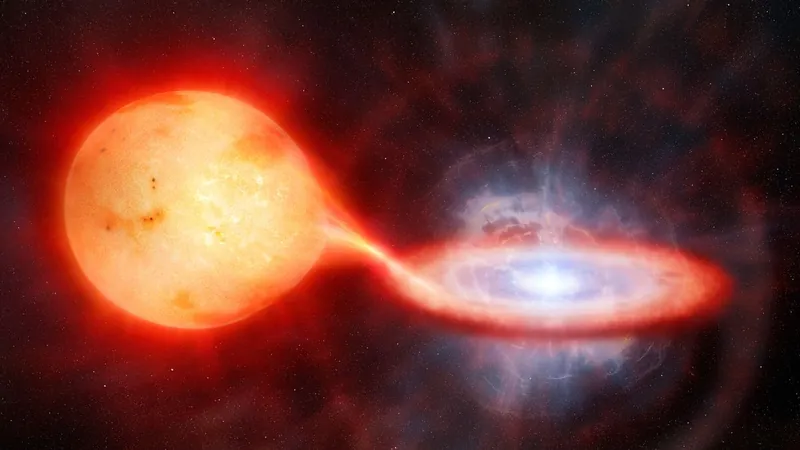
Hold onto Your Hats! Is the 'Blaze Star' T Corona Borealis Poised for a Dramatic Explosion?
2025-03-26
Author: Mei
A Tantalizing Prediction
A tantalizing new prediction suggests that T Corona Borealis, often dubbed the "blaze star," may be on the verge of a nova explosion, possibly occurring on March 27, November 10, or June 25, 2026. However, some astronomers are expressing skepticism over these claims, questioning the methodology behind the predictions rooted in an observed pattern of the star system’s orbital dynamics.
The Nature of T Corona Borealis
Léa Planquart, an astrophysicist from the Institut d'Astronomie et d’Astrophysique at the Université Libre de Bruxelles, emphasized that T Corona Borealis has captivated both amateur and professional astronomers for over a century. The star is a symbiotic binary system—comprising a white dwarf siphoning material from a red giant, which marks an earlier evolutionary phase of its lifecycle. The white dwarf encapsulates the remnants of a once sun-like star, extraordinarily dense, crammed into a volume similar to that of Earth.
Nova Phenomenon
This unique relationship gives rise to a phenomenon known as a nova. The captured material from the red giant spirals into a disk around the white dwarf and eventually ignites a thermonuclear explosion on the surface of the white dwarf, which can shine as brightly as a new star visible from thousands of light-years away. Surprisingly, despite typically being dim at a magnitude of +10—requiring specialized telescopes or binoculars to observe—it can illuminate the night sky dramatically during a nova.
The History of T Corona Borealis
T Corona Borealis ranks among a select group of only 11 known "recurrent" novas—stars that experience multiple nova eruptions within less than a century between events. Historical records indicate it went nova in 1787, 1866, and most recently in 1946, prompting ongoing excitement and study.
Orbital Dynamics and Predictions
Observations suggest there may be a pattern in the timing of these explosions linked to the orbital dynamics of the white dwarf and red giant, which complete a cycle every 227.5687 days. Jean Schneider of the Paris Observatory proposes that extreme conditions may be triggered by a theorized third celestial body orbiting the white dwarf. This hypothetical companion could interact with the system every 79 to 80 years, enhancing the white dwarf's material intake.
While Schneider's radical theories have not yet garnered widespread acceptance, the potential for discovering new celestial phenomena raises compelling questions about the T CrB system. In 2016, an unexpected brightness surge in the system renewed interest and speculation about the presence of this yet-to-be-detected companion.
Super-Active Phase
Furthermore, more conservative analyses by Planquart indicate that the latest brightening of T Corona Borealis between 2015 and 2023 is likely a result of increased activity within the system. This “super-active phase” suggests a buildup of material, a typical precursor to a nova explosion.
Expected Outcome of a Nova Explosion
What can we anticipate if T Corona Borealis does erupt? Observers forecast that it could once again reach a remarkable brightness of magnitude +2, rendering it visible to the naked eye and potentially appearing as bright as prominent stars in the Big Dipper. With T CrB currently dim, visibility is limited to binoculars; however, a sudden brightness increase could lead to a swift change in observability—noted as an exhilarating prospect among astronomers hoping to witness the event.
Chandrasekhar Limit and Supernova Possibility
The intrigue doesn’t end there. The mass of the white dwarf within T Corona Borealis is 1.37 times that of the Sun, edging closer to the Chandrasekhar limit of 1.44 solar masses. Once it exceeds this limit, it may culminate in a catastrophic Type Ia supernova, obliterating the white dwarf entirely.
Continued Monitoring
While signs hint at an imminent nova from T Corona Borealis, scientists continue to monitor this dynamic system closely, eager for insights into its explosive future. Will we soon witness a spectacular cosmic display? As the stars come into alignment, the astronomical community is prepared for exciting developments in the days to come!
 Brasil (PT)
Brasil (PT)
 Canada (EN)
Canada (EN)
 Chile (ES)
Chile (ES)
 Česko (CS)
Česko (CS)
 대한민국 (KO)
대한민국 (KO)
 España (ES)
España (ES)
 France (FR)
France (FR)
 Hong Kong (EN)
Hong Kong (EN)
 Italia (IT)
Italia (IT)
 日本 (JA)
日本 (JA)
 Magyarország (HU)
Magyarország (HU)
 Norge (NO)
Norge (NO)
 Polska (PL)
Polska (PL)
 Schweiz (DE)
Schweiz (DE)
 Singapore (EN)
Singapore (EN)
 Sverige (SV)
Sverige (SV)
 Suomi (FI)
Suomi (FI)
 Türkiye (TR)
Türkiye (TR)
 الإمارات العربية المتحدة (AR)
الإمارات العربية المتحدة (AR)